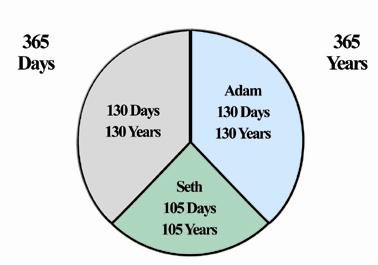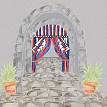Primary Ages of Adam and Seth Figure 1
365-Day-Year
365-Year-Cycle

260-Day-Sacred-Year
260-Year-Sacred-Cycle
Primary Ages of Adam and Seth Figure 1
260-Year-Sacred-Cycle
Primary Ages of Adam and Seth Figure 1
Genesis 5:3
"And
Adam lived an hundred and thirty years, and begat a son in his
own likeness,
after his image; and called his name Seth:"
after his image; and called his name Seth:"
Genesis 5:6
"And Seth lived an hundred and
five years, and begat Enos:"
260
Day-Sacred-Year Matches with 260 Year-Sacred-Cycle
105 Days per Year Matches With 105 Years
Primary 130-Year Age of Adam Matches with 130-Year Half of a 260-Year-Sacred-Cycle
And all the Days that …. were …. Years supports Numerical Matching
X Number of Days with X Number of Years
See Genesis 5:5
105 Days per Year Matches With 105 Years
Primary 130-Year Age of Adam Matches with 130-Year Half of a 260-Year-Sacred-Cycle
And all the Days that …. were …. Years supports Numerical Matching
X Number of Days with X Number of Years
See Genesis 5:5
 |
Entry to the Holy of Holies
prepares one for Holy Bible discussion about the most
sacred writings. The sanctuary within rests behind a
temple curtain. Precise definitions of ancient calendar
mathematics perhaps 10,000-years ago are in the
Antediluvian Calendar of the Patriarchs. The "begat"
family descendants following Adam is from chapter 5 of
Genesis. Like the ancestry of Kings and Pharaohs, entire
lunar/solar epochs of time describe the lifetime rule.
Cart Item EHH Similar article, Get the PDF
version for less than $ 1 from Paypal-Payloadz
|
 263 kb 0.99 |
 |
HoH_Secondary_800-Year_Age_of_Adam advances the secondary age category in the Holy_of_Holies. The secondary age category entails thirteen 400-year-Baktun-cycles in the vernacular of the Mayan calendar. Appended images and color coded text end Adam’s second 400-year-Baktun-cycle 2 to complete the first 800-year Generation Cycle 1 in the secondary age category. The Antediluvian Calendar Table system applies 13 steps of 400-year-Baktun-cycles to describe the 5200-year Great Cycle from Adam to Enoch. Cart Item HoHS800YAA Get this PDF article from Paypal-Payloadz for 99 cents! |  140 kb 0.99 |